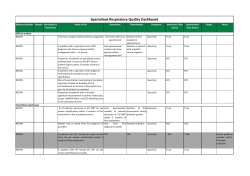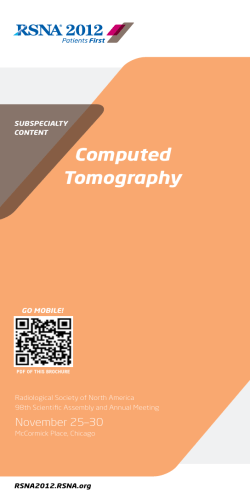
以急性缺血性中風和心機酵素升高為表現的嗜酸性細胞增多綜合症 Hypereosinophilic syndrome presented as acute ischaemic stroke and raised cardiac enzymes
Hong Kong Journal of Emergency Medicine Hypereosinophilic syndrome presented as acute ischaemic stroke and raised cardiac enzymes 以急性缺血性中風和心機酵素升高為表現的嗜酸性細胞增多綜合症 CY Cheung 張志遠, CL Fu 符朝麗, CS Li 李俊生 The hypereosinophilic syndromes (HES) are a group of disorders marked by the sustained overproduction of eosinophils, resulting in multiple organ damage. We report a 55-year-old lady presented with sudden onset of left-sided limb weakness and hypereosinophilia. Cerebral computerised tomography scan showed multiple small infarctions in bilateral corona radiata and right thalamus. A transesophageal echocardiogram revealed endomyocardial damage with mural thrombus suggesting Loeffler endocarditis. The multiple cerebral infarctions were probably due to cardiac thromboembolism. Treatment with prednisolone led to significant clinical improvement. This case illustrates hypereosinophilia should be considered in patients with multiple cerebral infarctions. (Hong Kong j.emerg.med. 2012;19:349-352) 嗜酸性細胞增多綜合症是一組因嗜酸性白細胞過度增長而導致多器官受損的疾病。我們呈報了一個55歲 女性表現為突發性左邊肢體無力和嗜酸性細胞增多的病例。腦掃描顯示在兩側的放射冠和右側丘腦有許 多細小的梗塞。經食道的心臟超聲波顯示心機內膜受損並有壁血栓形成這就提示了有Loeffler心內膜炎。 多處腦梗塞可能是由於心臟血栓形成。用強的松龍治療有明顯的臨床改善。這個個案顯示了對患有多處 腦栓塞的病人應該考慮嗜酸性細胞增多症。 Keywords: Cerebral infaction, coronary thrombosis, endocarditis, hematopoietic system; steroids 關鍵詞:腦栓塞、冠狀動脈血栓形成、心內膜炎、造血系統、激素 Introduction The hypereosinophilic syndromes (HES) are a group of disorders marked by the sustained overproduction of eosinophils, resulting in multiple organ damage. Cardiac involvement mostly presents as endomyocardial damage, which may lead to thrombus formation and Correspondence to: Cheung Chi Yuen, PhD, MRCP Queen Elizabeth Hospital, Department of Medicine, 30 Gascoigne Road, Kowloon, Hong Kong Email: [email protected] Fu Chiu Lai, MRCP Li Chun Sang, FRCP congestive heart failure. Thromboembolic strokes are not uncommon. Here we report a patient, presented with multiple cerebral infarctions and endomyocardial damage was subsequently diagnosed to have HES. Case A 55-year-old Chinese lady presented with 1-day history of left-sided limb weakness. She had neither chest pain nor shortness of breath. She had no significant past medical history except bleeding gastric ulcer. She never smoked or drank. Neurological examination revealed left hemiparesis with muscle power graded 2/5. Cardiac examination revealed a pansystolic murmur over the apex with radiation to 350 axilla. Both lymphadenopathy and hepatosplenomegaly were absent. The white cell count was 42.3x10 9/L (eosinophil count 30.4x109/L, neutrophil count 9.5x109/L, lymphocyte count 2.2x10 9/L and monocyte count 1.4x109/L). There were no blast cells in the peripheral blood. The haemoglobin was 13.1 g/dL and the platelet count was 158x10 9/L. The clinical history and basic investigations did not reveal a clue to any identifiable cause of hypereosinophilia which includes parasitic infection, neoplasm, vasculitis or allergy. Moreover, there were also no prior clinical signs and symptoms suggestive of Churg-Strauss syndrome. The creatinine kinase was 485 IU/L (normal <192 IU/L) and troponin I 12.2 ng/mL (normal <0.3 ng/mL). The blood glucose was 4.4 mmol/L, total cholesterol was 3.9 mmol/L (LDL-cholesterol=2.4 mmol/L, HDL-cholesterol= 0.6 mmol/L) and triglyceride was 1.9 mmol/L. Autoimmune markers including antinuclear factor and antineutrophil cytoplasmic antibodies were all negative. The electrocardiogram showed sinus rhythm with diffuse anterolateral ST segment depression. A transesophageal echocardiogram showed ruptured chordae tendineae of the anterior mitral valve leaflet Hong Kong j. emerg. med. Vol. 19(5) Sep 2012 with severe mitral regurgitation. There was a small thrombus at anterior mitral valve leaflet (Figure 1) with heterogeneous infiltration around aor tomitral junction. The blood culture revealed no bacterial growth. The C-reactive protein was <3.4 mg/L. Cerebral computed tomography (CAT) scan showed multiple small non-enhancing hypodense areas in bilateral corona radiata and right thalamus, which were suggestive of recent cerebral infarction (Figure 2). Doppler ultrasound of both carotid arteries did not reveal any haemodynamically significant stenosis. Bone marrow aspirate revealed marked eosinophilia (54% of marrow myeloid cells) without evidence of abnormal and/or clonal mast cells and T lymphocytes. Trephine biopsy also revealed no abnormal cellular infiltrate. There were no karyotypic abnormalities. Polymerase chain reaction (PCR) for FIP1L1-PDGFRalpha gene fusion was negative. PCR for BCR-ABL was also negative. She refused anticoagulation therapy and was given clopidogrel. Moreover, prednisolone 60 mg daily was started after the diagnosis of HES was confirmed. The RA=right atrium; RV=right ventricle; LA=left atrium; LV=left ventricle Figure 1. Transesophageal echocardiogram showing a small vegetation at anterior mitral valve leaflet (arrow). Cheung et al./Hypereosinophilic syndrome Figure 2. Cerebral computed tomography scan showed multiple small hypodense areas in bilateral corona radiata and right thalamus. eosinophil count normalised within 3 days. The dosage of corticosteroid gradually tailed down without recurrence of hypereosinophilia. The limb muscle power also gradually improved. The troponin I level dropped to 0.12 ng/mL two weeks after hospitalisation (3 days after corticosteroid). Coronary angiogram was normal. She refused mitral valve replacement and also defaulted follow up after discharge from hospital. Discussion The HES are characterised by sustained overproduction of eosinophils, in which eosinophilic infiltration and mediator release can cause damage to multiple organs.1,2 The original definition of HES included three defining features:3 (1) Blood eosinophilia of 1500/microliter, present for more than six months. (2) No other apparent aetiologies for eosinophilia, such as parasitic infection or allergic disease. (3) Signs and/or symptoms of eosinophilmediated end-organ dysfunction. Some HES patients, as in our patient, may require therapeutic interventions before the six month period specified in the first criterion, in order to treat or prevent potentially disabling or lifethreatening complications of sustained hypereosinophilia. As a result, the six month duration criterion is no longer 351 applied in the modern definition because there is no reason to withhold treatment in a patient with sustained and potentially deleterious hypereosinophilia once underlying diseases have been excluded. With the recent advances in molecular and genetic diagnostic techniques and recognition of different clinical presentations, it was found that HES should encompass a heterogeneous group of conditions: namely 'myeloproliferative variants (M-HES)', 'lymphocytic variants (L-HES)', 'familial eosinophilia', 'undefined HES', 'overlap eosinophilic diseases', and 'eosinophilassociated diseases'.2 The relative frequencies of these variants are also not yet clear and may differ among referral centres. M-HES results from clonal expansion of eosinophilic precursors due to various mutations while L-HES results from increased secretion of eosinophilic cytokines like interleukin 5 by T lymphocytes. However, most HES patients lack aetiologic understanding for their hypereosinophilia and belong to the 'undefined HES' subcategory. 2 Diagnosis of undefined HES requires the exclusion of clonal eosinophilia and absence of phenotypically abnormal and/or clonal T lymphocytes. This requires careful assessment of the peripheral blood smear, bone marrow morphologic features, cytogenetic analysis, molecular studies including screening for FIP1L1PDGFRalpha gene fusion, and peripheral blood lymphocyte phenotyping and T-cell receptor gene rearrangement studies. The most common presenting clinical manifestations of HES are cardiac (54-73%), cutaneous (50-73%), pulmonary (40-64%) and neurologic (35-73%). Cardiac involvement is a major cause of mortality and morbidity among patients with HES. 1,3,4 However, recent data suggest that organ involvement may vary considerably, based on the HES subtype. In fact, the cardiac manifestations of HES are more likely to occur with M-HES. Eosinophil-mediated cardiac damage invo lves in creased numbers of eos inophils in conjunction with other ill-defined stimuli that recruit and/or activate eosinophils within the heart tissues. Extracellular deposition of eosinophil granule proteins and evidence of eosinophil activation are present at sites of myocardial injury.4 Eosinophil-mediated heart damage evolves through three stages: 1 (1) An acute necrotic stage; (2) An intermediate phase characterised Hong Kong j. emerg. med. Vol. 19(5) Sep 2012 352 by thrombus formation along the damaged endocardium; (3) A fibrotic stage. Common findings include shortness of breath, chest pain, signs of heart failure, cardiomegaly, mitral or tricuspid regurgitation and T wave abnormalities on the electrocardiogram. Several reports have shown that contrast-enhanced cardiac magnetic resonance imaging (MRI) reliably detects all stages and aspects of eosinophil-mediated heart damage, including the early stage of myocardial eosinophilic inflammation. Endomyocardial biopsy may be required to provide the definitive diagnosis of eosinophil-associated cardiac involvement. Echocardiography or cardiac MRI can demonstrate intracardiac thrombi and may also show evidence of fibrosis in the fibrotic stage. Elevated cardiac enzymes in our patient can be sensitive indicators of early and ongoing eosinophil-associated myocardial damage. features of M-HES is the tyrosine kinase inhibitor, imatinib mesylate. 7 Patients with co-existing cardiac disease should receive concomitant glucocorticoids when therapy with imatinib is initiated to prevent acute necrotising myocarditis. However, cardiac symptoms due to structural abnormalities resulting from endomyocardial fibrosis, and fixed neurological deficits may not improve with imatinib therapy.8,9 In conclusion, this case illustrates that HES might cause endomyocardial injury and ischemic strokes. For young patients with cerebral infarctions but without traditional risk factors, early appropriate analysis of the differential count of white blood cells would be indicated to rule out this rare but treatable disease. References Neurologic presentations of HES are largely caused by cerebral infraction, although other manifestations such as encephalopathy, peripheral neuropathy, or longitudinal and/or transverse sinus thrombosis may also occur.5 The infarction in our patient is probably related to the tiny emboli subsequent to intracardiac thrombus or vegetations formation. Moreover, the symptoms can also be attributed to the cerebrovascular endothelial damage and neurotoxicity from eosinophilic degranulation related to hypereosinophilia.5 Anticoagulation with warfarin and/or antiplatelet agents is often instituted once an embolic event has occurred. Warfarin is usually initiated for a mural thrombus in the heart, or venous thrombus in an intracranial sinus. Rapid lowering of the eosinophil count is important. Patients with HES should be evaluated for the presence of FIP1L1-PDGFRalpha fusion. In patients who do not have the FIP1L1PDGFRalpha fusion, the mainstay of treatment is corticosteroid. Prednisone challenge is best performed at the time of diagnosis to ascertain whether blood eosinophilia is suppressible by corticosteroids. A prolonged eosinopenic response 4 to 12 hours after administration is associated with better prognosis. Hydroxyurea and interferon alfa have also been effective in a number of small case series.6 On the other hand, the first-line therapy for patients with FIP1L1PDGFRalpha-positive disease or patients with other 1. 2. 3. 4. 5. 6. 7. 8. 9. Weller PF, Bubley GJ. The idiopathic hypereosinophilic syndrome. Blood 1994;83(10):2759-79. S h e i k h J , We l l e r P F. C l i n i c a l o v e r v i e w o f hypereosinophilic syndromes. Immunol Allergy Clin North Am 2007;27(3):333-55. Chusid MJ, Dale DC, West BC, Wolff SM. The hypereosinophilic syndrome: Analysis of fourteen cases with review of the literature. Medicine (Baltimore) 1975;54(1):1-27. Ogbogu PU, Rosing DR, Horne MK 3rd. Cardiovascular manifestations of hypereosinophilic syndromes. Immunol Allergy Clin North Am 2007;27 (3):457-75. Moore PM , H a rl ey JB , Fa uci AS . Neurol ogic dysfunction in the idiopathic hypereosinophilic syndrome. Ann Intern Med 1985;102(1):109-14. Butterfield JH. Treatment of hypereosinophilic sy ndromes with prednis one, hy droxyurea, a nd interferon. Immunol Allergy Clin North Am 2007;27 (3):493-518. Cools J, DeAngelo DJ, Gotlib J, Stover EH, Legare RD, Cortes J, et al. A tyrosine kinase created by fusion of the PDGFRA and FIP1L1 genes as a therapeutic target of imatinib in idiopathic hypereosinophilic syndrome. N Engl J Med 2003;348(13):1201-14. Klion AD, Robyn J, Akin C, Noel P, Brown M, Law M, et al. Molecular remission and reversal of myelofibrosis in response to imatinib mesylate treatment in patients with the myeloproliferative variant of hypereosinophilic syndrome. Blood 2004;103(2): 473-8. Vandenberghe P, Wlodarska I, Michaux L, Zachée P, Boogaerts M, Vanstraelen D, et al. Clinical and molecular features of FIP1L1-PDFGRA (+) chronic eosinophilic leukemias. Leukemia 2004;18(4):734-42.
© Copyright 2026





















